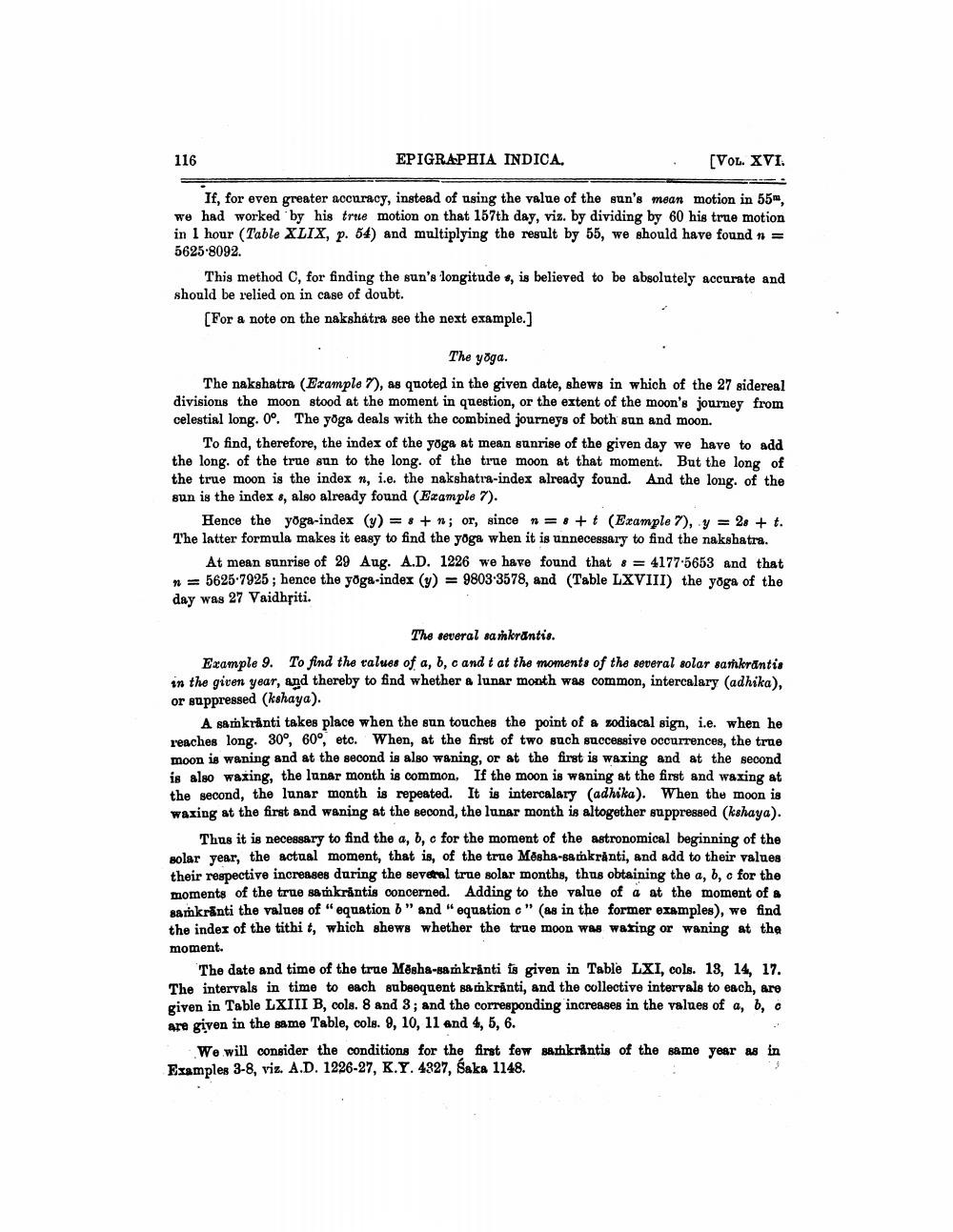________________
EPIGRAPHIA INDICA.
[VOL. XVI.
If, for even greater accuracy, instead of using the value of the sun's mean motion in 55m, we had worked by his true motion on that 157th day, viz. by dividing by 60 his true motion in 1 hour (Table XLIX, p. 54) and multiplying the result by 55, we should have found n = 5625.8092.
116
This method C, for finding the sun's longitudes, is believed to be absolutely accurate and should be relied on in case of doubt.
[For a note on the nakshatra see the next example.]
The yoga.
The nakshatra (Example 7), as quoted in the given date, shews in which of the 27 sidereal divisions the moon stood at the moment in question, or the extent of the moon's journey from celestial long. 0°. The yoga deals with the combined journeys of both sun and moon.
To find, therefore, the index of the yoga at mean sunrise of the given day we have to add the long. of the true sun to the long. of the true moon at that moment. But the long of the true moon is the index n, i.e. the nakshatra-index already found. And the long. of the sun is the index 8, also already found (Example 7).
Hence the yoga-index (y)+n; or, since nt (Example 7), y = 28 + t. The latter formula makes it easy to find the yoga when it is unnecessary to find the nakshatra.
8
At mean sunrise of 29 Aug. A.D. 1226 we have found that = 4177-5653 and that n = 5625-7925; hence the yoga-index (y) = 9803-3578, and (Table LXVIII) the yoga of the day was 27 Vaidhriti.
The several samkrāntis.
Example 9. To find the values of a, b, c and t at the moments of the several solar samkrāntis in the given year, and thereby to find whether a lunar month was common, intercalary (adhika), or suppressed (kshaya).
A samkrānti takes place when the sun touches the point of a zodiacal sign, i.e. when he reaches long. 30°, 60°, etc. When, at the first of two such successive occurrences, the true moon is waning and at the second is also waning, or at the first is waxing and at the second is also waxing, the lunar month is common. If the moon is waning at the first and waxing at the second, the lunar month is repeated. It is intercalary (adhika). When the moon is waxing at the first and waning at the second, the lunar month is altogether suppressed (kshaya).
Thus it is necessary to find the a, b, c for the moment of the astronomical beginning of the solar year, the actual moment, that is, of the true Mesha-samkranti, and add to their values their respective increases during the several true solar months, thus obtaining the a, b, c for the moments of the true samkrāntis concerned. Adding to the value of a at the moment of a samkranti the values of "equation b" and "equation c" (as in the former examples), we find the index of the tithi t, which shews whether the true moon was waxing or waning at the moment.
The date and time of the true Mesha-samkranti is given in Table LXI, cols. 13, 14, 17. The intervals in time to each subsequent samkranti, and the collective intervals to each, are given in Table LXIII B, cols. 8 and 3; and the corresponding increases in the values of a, b, c are given in the same Table, cols. 9, 10, 11 and 4, 5, 6.
We will consider the conditions for the first few sankrantis of the same year as in Examples 3-8, viz. A.D. 1226-27, K.Y. 4327, Śaka 1148.
3




